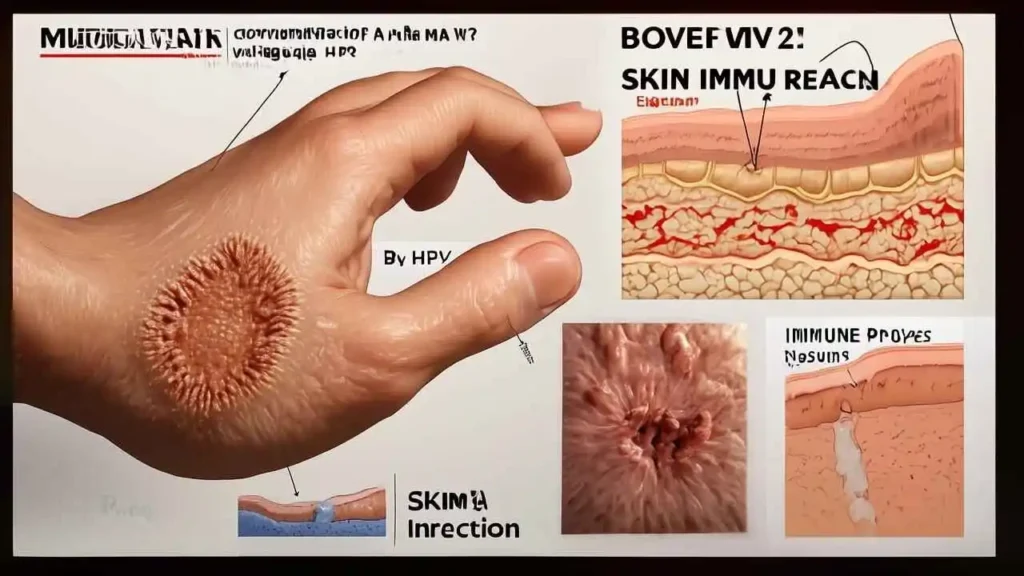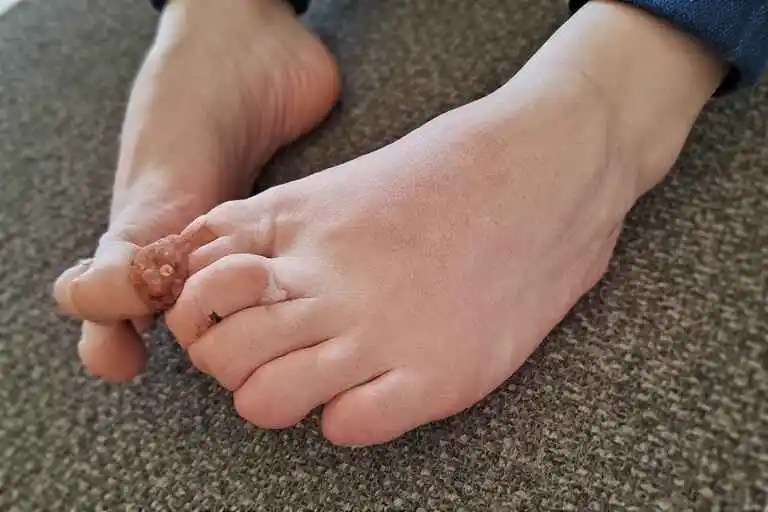
Preventing Verruca Vulgaris: Tips to Avoid Common Warts
Of the many common skin afflictions we might encounter in our lifetime, few are as familiar as the common wart. Known medically as Verruca Vulgaris, these small, benign growths can appear seemingly out of nowhere, often on our hands or fingers. While they are typically harmless, their presence can be bothersome, and understanding what they are, why they appear, and how we can manage them is the first step toward clear, healthy skin.
In this comprehensive guide, we will explore the world of Verruca Vulgaris. We’ll delve into its viral origins, learn to identify its key symptoms, understand the diagnostic process, and navigate the wide array of available treatments, from simple home remedies to advanced medical procedures.
What Exactly is Verruca Vulgaris? Unveiling the Common Wart
Often a source of mild annoyance and cosmetic concern, Verruca Vulgaris, more commonly known as the common wart, is a fascinating example of how a microscopic invader can manifest visibly on our skin. At its core, Verruca Vulgaris is a benign (non-cancerous) epidermal proliferation – essentially, an excessive, harmless growth of the outermost layer of the skin. It’s not a disorder of the skin itself in the way eczema or psoriasis might be, but rather a direct consequence of a viral infection in that superficial skin layer.
The true orchestrator behind this common skin condition is the Human Papillomavirus (HPV). It’s crucial to understand that while HPV is a broad family of viruses, with hundreds of different types, the specific strains responsible for causing common warts are generally low-risk, non-oncogenic types (such as HPV types 1, 2, 4, and 7, among others). These particular strains are distinct from the high-risk HPV types associated with more serious health conditions like certain cancers (e.g., cervical cancer). Therefore, having a common wart does not typically pose a risk for developing other, more serious health problems.
The journey of a common wart begins when one of these wart-causing HPV strains manages to penetrate the skin’s protective barrier. This typically occurs through micro-abrasions, tiny cuts, scratches, or even seemingly invisible breaks in the skin, which can happen through everyday activities, especially on areas prone to wear and tear. Once the virus gains entry into the living cells of the epidermis (the top layer of skin), it doesn’t just sit there; it effectively “reprograms” these skin cells, known as keratinocytes.
This viral takeover triggers an abnormal and accelerated overgrowth of these skin cells. Instead of shedding at their normal rate, the infected keratinocytes multiply rapidly and mature incorrectly, leading to a significant increase in their numbers and a disorganization of their usual structure. This rapid and excessive multiplication of skin cells on the outer layer creates the characteristic rough, raised, and oftendome-shaped or cauliflower-like texture that we instantly recognize as a wart. The surface often appears irregular and can sometimes have small black dots, which are actually tiny clotted (thrombosed) blood vessels.
Verruca Vulgaris can appear anywhere on the body, but they are most frequently found on areas prone to minor trauma or friction. This includes the hands, fingers, and around the nails (periungual warts), where they are easily spread through direct contact or indirectly via shared objects. They are also commonly seen on the knees and elbows, especially in children, due to frequent scrapes and bumps in these areas. While less common for the “vulgaris” type, they can also develop on soles of the feet (though these are often classified as plantar warts, a specific type of common wart that grows inward due to pressure) or other exposed body parts.
While generally harmless and often painless, warts can be a source of discomfort if they occur on pressure points, are frequently irritated, or if they are cosmetically bothersome. They are also contagious, meaning they can spread to other parts of the body (autoinoculation) or to other individuals through direct skin-to-skin contact or contact with contaminated surfaces. The body’s immune system usually learns to recognize and fight off the virus over time, which is why many common warts eventually resolve spontaneously, though this can take months or even years.
Unmasking the Culprit: Understanding the Causes and Key Risk Factors for Wart Development
Warts, those common skin growths, are more than just a nuisance; they are a direct manifestation of a viral infection. To understand them, we must first identify the primary instigator.
The Root Cause: Human Papillomavirus (HPV)
The fundamental cause of virtually every common wart (medically known as verruca vulgaris) is direct exposure to and infection by a specific, wart-causing strain of the Human Papillomavirus (HPV). It’s crucial to understand that there are over 100 different strains of HPV, and only a subset of these are responsible for common skin warts, which are typically benign (non-cancerous). This remarkably common virus is ubiquitous in our environment, meaning it’s almost everywhere. Once a compatible HPV strain encounters a susceptible host, it infects the superficial layers of the skin, causing skin cells to grow more rapidly than usual, leading to the characteristic raised, rough lesion we recognize as a wart.
Transmission of these wart-causing HPV strains can occur through several primary pathways:
- Direct Skin-to-Skin Contact: This is arguably the most straightforward and frequent method of transmission. Even a seemingly innocuous interaction, such as shaking hands with someone who has a wart on their hand, can be enough to transfer the virus. The risk significantly increases if there’s any compromise to the skin’s integrity, even a microscopic break, which provides an easy entry point for the virus. This direct contact can occur in various scenarios, from casual touch to more prolonged physical interactions in sports or shared living spaces.
- Indirect Contact (Fomite Transmission): HPV can survive for a limited period outside the human body on inanimate objects, known as fomites. This means you don’t necessarily need to touch an infected person directly to contract the virus. We can inadvertently pick up viral particles by touching contaminated surfaces or objects. Common examples include:
- Personal items: Sharing towels, washcloths, razors, or nail clippers with an infected individual.
- Public surfaces: Touching doorknobs, handrails, gym equipment, yoga mats, or shared toys.
- Communal areas: Walking barefoot in warm, moist environments like public locker rooms, showers, swimming pool decks, or martial arts studios is a particularly common source of plantar warts (warts on the feet, which are a close variant of verruca vulgaris and thrive in such conditions).
- Autoinoculation (Self-Spreading): This term refers to the process by which an individual spreads the virus from one part of their own body to another. It’s a critical mechanism for the multiplication and expansion of warts. If you have an existing wart and you pick at it, scratch it, bite it, shave over it, or even use an emery board on it and then on unaffected skin, you can inadvertently transfer viral particles to new areas. This provides fresh entry points for the virus, leading to the formation of new warts, often in clusters or lines along areas of trauma.
Factors Increasing Susceptibility: Who is More at Risk?
While HPV is remarkably common and anyone can theoretically get a wart upon exposure, certain individuals are far more susceptible due to various predisposing factors. These key risk factors include:
- Age: Children and young adults are disproportionately affected by warts. There are several reasons for this increased prevalence:
- Developing Immune Systems: Their immune systems are still maturing and have not yet built up a comprehensive immunological memory or strong defenses against the many strains of HPV they encounter.
- Frequent Close Contact: Children often engage in more direct physical contact during play at school, daycare, or sports.
- Less Developed Hygiene Habits: Habits like handwashing might not be as rigorous, increasing exposure and transmission.
- Weakened or Compromised Immune System: Individuals whose immune systems are not functioning optimally have a much harder time fighting off viral infections, including HPV. This can be due to:
- Medical Conditions: Such as HIV/AIDS, autoimmune diseases, or certain cancers.
- Medical Treatments: Patients undergoing chemotherapy, taking immunosuppressant drugs (e.g., after organ transplantation), or long-term corticosteroid use. A subdued immune response means the body is less effective at identifying and eliminating the viral invaders, making it easier for warts to develop and persist.
- Breaks in the Skin: The skin acts as our body’s primary protective barrier. Any disruption to this barrier makes it significantly easier for HPV to gain entry. This includes:
- Cuts, Scrapes, and Abrasions: Even minor, often unnoticeable micro-traumas.
- Dry, Cracked Skin: Especially common on hands and feet.
- Skin Conditions: Chronic conditions like eczema, dermatitis, or even excessive chapping can compromise the skin’s integrity, providing multiple entry points for the virus.
- Specific Personal Habits: Certain repetitive behaviors can inadvertently create environments conducive to HPV infection:
- Nail Biting and Picking at Hangnails: These habits create microscopic tears and open wounds around the fingers and nail beds, providing perfect, moist entry points for HPV. The constant irritation can also lead to repeated autoinoculation.
- Improper Foot Care: Not thoroughly drying feet, especially between the toes, after showering or swimming can create a damp environment that encourages viral survival and entry, particularly for plantar warts.
- Shaving: Shaving over existing warts can spread the virus to new areas on the body, similar to autoinoculation.
Understanding these causes and risk factors is crucial for effective prevention and management strategies against common warts.
Recognizing Verruca Vulgaris: Symptoms and Appearance
Verruca vulgaris, more commonly known as the common wart, is a benign skin growth caused by the human papillomavirus (HPV). While a definitive diagnosis should ideally be confirmed by a healthcare professional, understanding its characteristic visual cues can empower individuals to perform an initial self-assessment. The diagnosis of common warts is often straightforward due to their distinctly identifiable appearance and texture. If you’re examining a bump on your skin and suspect it might be a wart, here are the classic characteristics to carefully observe:
Key Visual and Tactile Characteristics to Look For:
- Growth Pattern and Texture: Common warts typically present as small, firm, fleshy, and grainy growths that protrude from the skin’s surface. They are not flat but rather elevated and can range in size from a pinpoint to over a centimeter in diameter. The term “grainy” refers to their often irregular, papillomatous surface.
- A Rough, Cauliflower-Like Surface Texture: This is one of the most defining features. The wart’s surface is not smooth but highly irregular, uneven, and hyperkeratotic (thickened), often resembling the florets of a mini-cauliflower or a solid dome with a rough, warty top. This texture is palpable and distinct from the surrounding smooth skin.
- Coloration: The color of a common wart can vary. Most frequently, they are flesh-colored, blending in with the surrounding skin. However, they can also appear slightly lighter, manifesting as white or off-white. Depending on blood supply and individual skin tone, they might also present as pink or light tan. In some cases, prolonged exposure or certain locations can cause them to become darker and more brown or grayish.
- Often Speckled with Tiny Black Dots: This is a highly characteristic and diagnostic sign. Upon close inspection, especially if the surface of the wart is lightly scraped or pared down, you might observe tiny, dark, pinpoint-sized specks embedded within the growth. It is a common misconception that these are “seeds” of the wart. In reality, they are small, clotted (thrombosed) blood vessels, which appear black due to dried blood. These capillaries grow into the wart to supply it with nutrients, and their presence helps differentiate warts from other benign skin lesions like corns or calluses.
Pain and Discomfort:
Typically, most common warts are painless. Their presence is usually more of an aesthetic concern or a mild annoyance. However, their location can significantly influence the level of discomfort experienced:
- Pressure-Induced Pain: If a wart develops in an area that is frequently bumped, rubbed, or subjected to significant pressure, it can cause discomfort, tenderness, or even minor pain. This is particularly common for warts on the soles of the feet (plantar warts), which can feel like walking on a pebble, or those on the fingers or around the nail beds that are constantly used or hit.
- Friction-Related Irritation: Warts in areas of high friction (e.g., under jewelry, on areas of clothing contact) can become irritated, inflamed, and subsequently painful.
- Secondary Infection: In rare cases, a wart might become painful if it experiences secondary bacterial infection, though this is not a primary symptom of the wart itself.
In summary, while common warts are generally harmless and often resolve on their own, their distinct visual characteristics, especially the rough surface and presence of black dots, make them quite recognizable. Understanding these signs is the first step in identifying these ubiquitous skin lesions. If the diagnosis remains uncertain, the wart becomes painful, changes significantly in appearance, or spreads rapidly, it is always advisable to consult a healthcare professional.
Getting a Clear Picture: The Diagnostic Process for Verruca Vulgaris
The diagnosis of Verruca Vulgaris, commonly known as common warts, is often a straightforward process, primarily relying on a thorough clinical examination. For the vast majority of cases, a healthcare provider, such as a general practitioner (GP), a dermatologist, or even a pediatrician, can make a confident diagnosis simply by observing the characteristic appearance of the lesion. These distinct visual cues typically include a rough, granular, and often cauliflower-like texture, a flesh-colored to slightly brownish hue, and the presence of small, hard, raised bumps, usually found on the hands, fingers, feet, or knees. The unique presentation of these growths is usually enough for an experienced clinician to arrive at a confident and accurate diagnosis without the need for invasive procedures.
While visual confirmation is usually sufficient, there are specific circumstances that warrant a more in-depth assessment. A doctor might take further steps if the growth presents with an unusual or atypical appearance (e.g., irregular shape, rapid expansion, atypical coloration, or signs of ulceration). Furthermore, persistent pain or discomfort, or a lack of response to conventional initial treatments despite consistent application, would prompt additional investigation. Most importantly, if there is any uncertainty regarding the diagnosis or suspicion of another dermatological condition mimicking a wart – particularly a concern about potential malignancy like skin cancer – further diagnostic measures become necessary.
One common diagnostic technique employed in such cases involves gently paring down the lesion. This careful removal of the superficial layers of the wart, often performed with a scalpel or blade, allows the clinician to look for the classic “black dots” or “seed warts.” These pinpoint black specks are actually thrombosed (clotted) capillaries, tiny blood vessels that have become occluded and are a tell-tale sign characteristic of Verruca Vulgaris. Their presence strongly indicates a viral infection and helps differentiate common warts from other benign skin growths.
In very rare or ambiguous situations, particularly when there is significant diagnostic uncertainty, an atypical presentation, or compelling reason to definitively rule out more serious conditions like various forms of skin cancer (e.g., squamous cell carcinoma, basal cell carcinoma, or even melanoma), a skin biopsy may be performed. This procedure involves the precise removal of a small tissue sample from the growth, usually under local anesthetic to minimize discomfort. The collected sample is then sent to a specialized pathology laboratory for microscopic analysis by a trained pathologist. This detailed histopathological examination allows for a definitive diagnosis by identifying the characteristic cellular changes associated with human papillomavirus (HPV) infection, such as the presence of koilocytes, and crucially, to confirm the benign nature of the growth or to definitively diagnose and classify any other underlying skin lesion.
Treatment Options
Verruca vulgaris, more commonly known as the common wart, is a benign skin growth caused by the human papillomavirus (HPV). While these small, raised bumps are incredibly common, particularly among children and teenagers, one of their most fascinating characteristics is their potential for spontaneous regression. Often, especially in younger individuals, the body’s immune system eventually recognizes the viral invaders and effectively clears the infection, leading to the wart’s disappearance over a period of months or even a couple of years.
However, waiting for this natural resolution isn’t always practical or desirable. Many individuals actively seek treatment to accelerate the healing process, alleviate associated discomfort (such as pain when walking on plantar warts), address cosmetic concerns, or prevent the warts from spreading to other areas of the body or to other people.
Fortunately, a wide array of treatment options exists, ranging from accessible, simple over-the-counter remedies that can be applied at home, to more potent professional medical procedures performed by dermatologists or other healthcare providers. The choice of treatment often depends on the wart’s size, location, number, the patient’s age and overall health, and their willingness to commit to a particular regimen.
Over-the-Counter (OTC) Approaches



